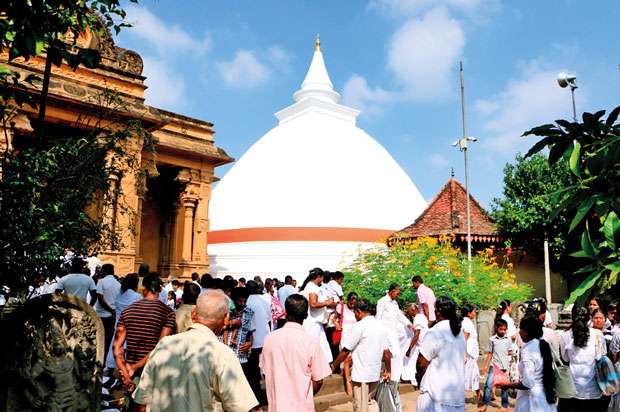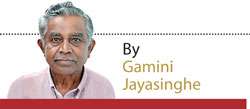19 Jan 2019 - {{hitsCtrl.values.hits}}

 Annually during the month of Duruthu (January) the most colourful Duruthu Perahera is held at Kelaniya Raja Maha Viharaya premises to commemorate the Gautama Buddha’s third visit to Lanka. According to chronicles the Exalted One visited Kelaniya on the Vesak Full Moon Poya Day eight Years after Enlightenment at the invitation of Naga King Maniakkhika. This invitation was made when the Blessed one visited Nagadipa three years earlier to quell a rebellion among Nagas of Nagadipa led by Chulodara and Mahodara. The Nagas offered a Gem Throne to the Blessed One on which He sat to preach Dharma. The Gem studded Throne was enshrined in the Dagaba built by King Yatalatissa who reigned in the third century B.C. In addition to this Dagaba which is sixty cubits (80 ft.) in height the King built a temple at the place where the Buddha was seated to preach Dharma. The Dagaba is in the shape of a heap of paddy and its circumference is 180 ft. In the temple premises are devalayas dedicated to Kataragama, Vishnu, Natha and Vibhishana gods.
Annually during the month of Duruthu (January) the most colourful Duruthu Perahera is held at Kelaniya Raja Maha Viharaya premises to commemorate the Gautama Buddha’s third visit to Lanka. According to chronicles the Exalted One visited Kelaniya on the Vesak Full Moon Poya Day eight Years after Enlightenment at the invitation of Naga King Maniakkhika. This invitation was made when the Blessed one visited Nagadipa three years earlier to quell a rebellion among Nagas of Nagadipa led by Chulodara and Mahodara. The Nagas offered a Gem Throne to the Blessed One on which He sat to preach Dharma. The Gem studded Throne was enshrined in the Dagaba built by King Yatalatissa who reigned in the third century B.C. In addition to this Dagaba which is sixty cubits (80 ft.) in height the King built a temple at the place where the Buddha was seated to preach Dharma. The Dagaba is in the shape of a heap of paddy and its circumference is 180 ft. In the temple premises are devalayas dedicated to Kataragama, Vishnu, Natha and Vibhishana gods.
Tsunami situation in Kelaniya area
In the legend there is a story of King Kelanitissa who in the second century B.C. angered over a love affair between his wife and brother executed an Arahant by burning him alive in a cauldron of boiling oil. The story continues that the custodian deities of Sri Lanka were angered by the cruel act of the King and caused the sea to flow inland. This was indeed a Tsunami which was about seven Gawwas (28 miles) from the coast and was reduced to about six Gawwas (24 miles) which means that a stretch of land about four miles in this coast had been washed away. According to legends the king had to float his daughter, Vihara Maha Devi in the sea to appease the guardian deities. The boat carrying Vihara Maha Devi was washed away to the Southern coast of Lanka and was recovered by the Rohana King, Kavantissa at Magama and he married her. Their son, Dutugemunu fought against the Chola king, Elara and unified the country. There is chronicle evidence to the effect that there were many bhikkhus in Kelaniya during the time of the unification of the country by king Dutugemunu and more than five hundred bhikkhus from Kelaniya participated in the Relic Depositing ceremony of Ruwanweliseya. According to chronicles king Kanistatissa (164/192 A.D.) had constructed a poyage (house set apart for Buddhist monks’ private confessions) at Kalaniya viharaya. King Voharatissa had constructed a parasol over the dagaba. During the Dambadeniya period Kelaniya sacred area had been in a dilapidated condition due to the foreign invasion but King Parakramabahu ll (2150 -1285) who had renovated the Sath Mahal Prasadaya (pyramidal tower of seven storeys), Oth pilimage (house for the image in the reclining position), Thinna image house (main Buddha statues carved in three places) had paved the Satharas Maha Maluwa (three square court yard) of Kelani Viharaya with granite and had constructed a Mandapaya (pavilion). He had also offered a coconut grove to the Kelaniya temple to perform daily rites.
Bhikkhus from Burma for Upasampada
During the Jayewardenepura/Kotte period this sacred place was known as Kelani Raja Maha Viharaya. King Sri Parakramabahu VI (1412 -1467) had renovated Kelani Viharaya. During the reign of king Buwanekabahu VI (1470 -1478A.D) Dharmachethiya king of Burma had sent some bhikkhus from that country to attain the Higher Ordination (Upasampada) at Kelani Ganga where Buddha had bathed during His visit. They were ordained to full priesthood by twenty five bhikkhus led by Veedagama Maha thera. The Burmese king had constructed a Sima Malakaya known as Kelani Sima.
The original paintings on the shrine walls have been added during the reign of king Voharakatissa.
Destruction caused by Kalinga Magha
Kalinga Magha from South India who invaded the island destroyed shrines and temples in our country including the Kelaniya temple but king Vijayabahu 11 rebuilt almost all the temples and Kelaniya temple was returned to its former glory.
Invasion of Portuguese
Again after the invasion of the Portuguese during the sixteenth century the temple was destroyed but King Keerthi Sri Rajasinghe the reigning king of Kandy rebuilt it in 1767 A.D. It was Mrs. Helena Wijewardena and the members of her family that brought this ancient sacred place to the present condition. Since 1888 A.D the famous artist, Solius Mendis restored the interiors of the temple building to the former glory. For more than 20 years artist Mendis painted frescoes depicting the lives of the Enlightened One and scenes from Buddhist History in Sri Lanka. He also added geometric ceiling paintings to the temple hall.
Splendid example of Buddhist architecture
Kelaniya temple is a splendid example of Buddhist architecture and art. At the entrance to the temple there is a Makara Torana (Arch way) constructed during the reign of King Keerthi Sri Rajasinghe. Makara is a symbol of protection in local mythology and is a stylized depiction of animals combined into an elaborate pattern. Makara has a body of a fish, feet of a lion, ears of a pig, and trunk of an elephant, tail of a swan and mouth and teeth of a monkey.
The Gem studded Throne was enshrined in the Dagaba built by King Yatalatissa who reigned in the third century B.C. In addition to this Dagaba which is sixty cubits (80 ft.) in height the King built a temple at the place where the Buddha was seated to preach Dharma
Shrine built on a rock platform
The shrine of Kelaniya is built on a rock platform and the external part of the foundation has three rows of carved figures. There is a row of swans and the middle row is of carved Bahirawayas-the terrible ones holding the entire edifices with the ugly expression of the faces that shows anger, disgust and pain. The third row of figures on the outside walls are statues of Hindu deities, Gana Deviyo,(god of wisdom) goddess Ganga, god Vishnu, Vibhishana (Rawana’s brother), Maithri Bodhisattva, Naga King Maniakkhika and god Skandha Kumara (god Karkithikeya- Katharagama deviyo –god of war).
Traditional Sandakada Pahana and paintings depicting the king’s fit of rage
At the entrance to the temple there is a traditional Sandakadapahana or Moonstone flanked by two Gajasinghe images with a body of the lion and head of an elephant. Inside walls of the hall are painted depicting Jathaka stories, myths and legends including King Kelanitissa’s execution of an Arahant in his fit of rage.
Reclining statue of the Enlightened One
The eighteen cubits longReclining statue of the Enlightened One is the main focus of the temple. It is in the darkened hall. The only light in the day time is the stream of light peeping from the entrance to the shrine room. There are statues of Buddha including the Buddha statue in the meditating posture in the main hall adjoining the shrine room of the reclining Buddha statue.
Dagaba in the shape of a heap of paddy
To the right side of the shrine there is the dagaba built in the shape of a heap of Paddy. Incidentally this is the best example of a Dhanyakkara style of dagaba. At the request of the Naga king this dagba is said to have been built to mark the place where the Buddha sat on a gem studded throne to preach Dhamma. This golden throne inlaid with precious stones is believed to have been enshrined in the dagaba.
Sacred Bo tree of Kelaniya Raja Maha Viharaya
To the left of the shrine is the Bo tree of the same species as the tree which provided shelter to the Buddha during His meditation.
Local and foreign visitors attracted
Since the Kelaniya temple is situated close to Colombo many visitors both local and foreign are drawn to explore its architecture, statues, frescoes especially the Dhanyakkara dagaba built on the site where the Buddha sat to preach Dhamma. The Kelaniya temple situated by the side of the Kelani Ganga has an attractive environment with scenic beauty.
30 Nov 2024 13 minute ago
30 Nov 2024 3 hours ago
30 Nov 2024 5 hours ago
30 Nov 2024 6 hours ago
29 Nov 2024 29 Nov 2024